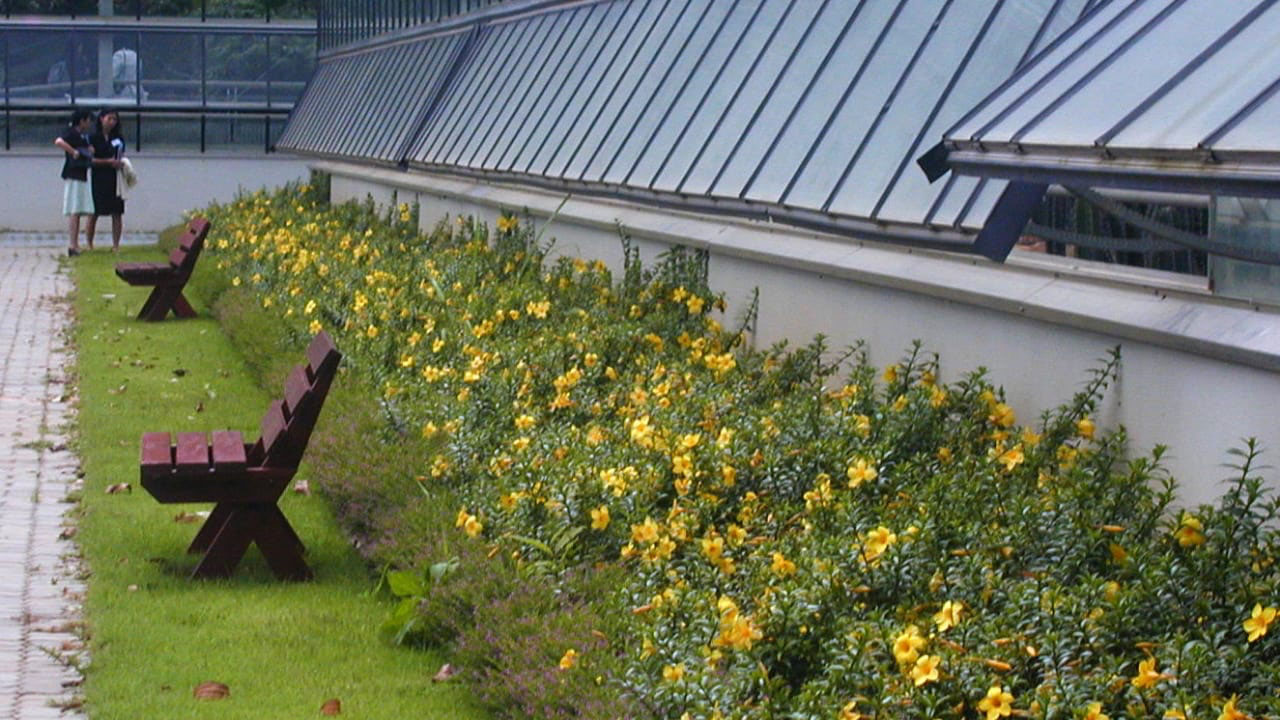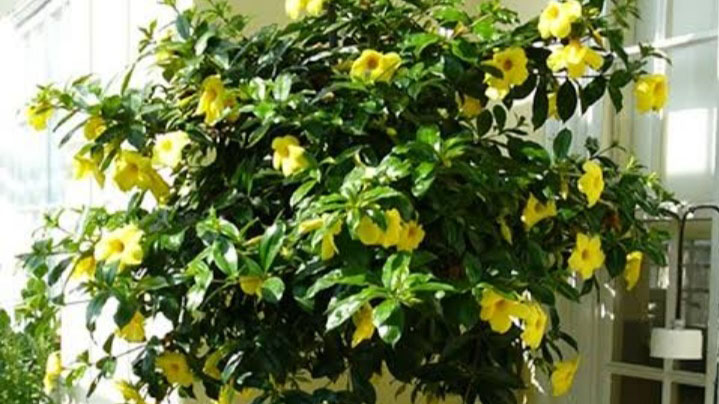 The genius Allamanda, a Yuletide plant that originated from tropical America, contains between 12 and 15 species of evergreen vines, and shrubs, including both semi-climbing and upright types.
The genius Allamanda, a Yuletide plant that originated from tropical America, contains between 12 and 15 species of evergreen vines, and shrubs, including both semi-climbing and upright types.
Members of the dogbane (Apocynaceae) family include the famous fragrant plumeria (frangipani), showy desert rose – Adeniums, and the lovely white-flowered Tabernaemotanas (pinwheel flowers).
There are not many plants as popular in tropical climates gardens as Allamanda cathartica with its golden trumpets covering the entire plant year-round. It is easy to cultivate, fast-growing and will add colour and sunshine to any landscape, in no time.
Allamanda cathartica “Brown Bud” Allamanda is the most commonly grown variety with reddish-brown flower buds which open into bright yellow blossoms as much as four inches across and six inches long. Although it is large and fast-growing, this is a well-behaved plant that won’t overtake your property while your back is turned. This vine needs some sort of support.

The long trainable stems of Allamanda cathartica admit them to classification as vining plants. But the growth is lax and pliable only when it is young and becomes brittle at maturity. Allamanda cathartica is a perennial plant, which becomes quite woody over time, but it requires a trellis or a fence for support.
It does not twine and does not have tendrils or aerial roots. These tropical plants are referred to as vines but they are really shrubs with long stems. It can be pruned into a shrub form. If not pruned, it can sprawl to a height of 6 meters (20 feet).
You must train it to go where you want since it doesn’t have twining tendrils. Otherwise you can grow it as a rambling shrub, ideal in a cottage garden landscape style. It is cultivated as an ornamental plant for its large beautiful flowers. The flowers are produced in clusters (cymes) at the stem tips throughout the year.
The yellow flowering vine is well known. Varieties in colour include yellow (single and double, dwarf, bush vines), cherry, white, peach, chocolate, cream and golden orange. Recently, a few new interesting cultivars were brought into the plant market, “cherry Jubilee” vine with waxy mauve flowers. It’s hard to believe they are real. They became one of the most sought-after. Cream and chocolate flowers vary in shades.
A very rare hybrid from Thailand with white flowers is called “Alba” or “Blanca.” It has smaller leaves and is a more delicate vine than the traditional vigorous yellow flower species. Some varieties, including “cherry” and “Blanca”, are sweetly fragrant, especially during warm evening hours.
Allamandas are different in shapes and growth habit. From a dwarf shrub (Allamanda schottii compacta) suitable for borders and ground cover to full sized shrubs are Allamanda cathartica and vigorous vines that can cover a fence with a beautiful mass within one to two seasons (Allamanda hendersonii, Allamanda violaceae “Cherry Jubilee”).
These luxuriant, colourful and flamboyant plants are the epitome of a tropical shrub. Popular for ornamental use in climates similar to their native habitat, these plants can also be grown in sheltered areas or conservatories in colder climates.
With care, they also make colourful indoor pot plant subjects in cooler climates.
The genus is named for an 18th-century Swiss botanist, Frederic Allamand. Allamada means “Heavenly Chief”. The milky sap of Allamanda cathartica plant contains a strong toxin, which may cause severe skin irritation. It is recommended to wear gloves when pruning it. All parts of the plant are poisonous if ingested, but pets and other animals are not affected. Avoid placing where children might munch.
In ethno-botanical use, traditional medicine, the roots are used against jaundice, complication with malaria and enlarged spleen. The flowers are used as a laxative. It has an antibiotic action against staphylococcus.
In tropical gardens, Allamandas are used in many ways – as accent or specimen plant in landscape or border, trained or espaliered against fence or wall, on all kinds of garden structures, and even as a showy hedge. In any climate, they are brilliant subjects for showy displays in outdoor containers, if they can be brought indoors for the winter.
Allamanda cathartica does not like the cold at all. As a tropical plant, it needs average to warm temperature, 18C (650-800 F). It will tolerate a minimum of 150C (590F) in cold climate. Also, this plant needs moderate to high humidity (50 per cent relative humidity or higher). Use a humidity tray or room humidifier. Even the northernmost gardener can enjoy an indoor Allamanda flowering vine. Allamanda is native to South America as such it requires high light, consistently warm temperatures and humidity of at least 50 per cent.
These conditions are hard to simulate in an average home in northern cold climates without grow lights, humidifiers and heaters.
Green house conditions are often ideal for Allamanda plant care. These golden trumpet houseplants can recharge and produce the amazing bright 5-inch blooms characteristic of the Allamanda.
Indoor Allamanda flowering vine needs structural support for the rambling stems. You can keep it pruned for a more compact plant. It is important to remember when pruning Allamandas that the blooms appear in clusters at the tip of new shoots, pruning or cutting back new shoots will affect the blooming of the plant. Prune carefully and selectively.
Landscape Uses: Equally at home in formal landscaping or a more casual setting, all this pretty shrub needs to keep it neat and tidy is trimming to bring out its naturally elegant form.
Its size and colour make it an ideal accent for a mixed bed, hedge or single specimen for the garden, vine for fence, wall lattice, trellis, arbor, porch or deck railing, anchor for a garden bed, as a backdrop for smaller plants, around the base of tall palms, on each side of a garden gate or entryway, corner accent for the house, privacy screen around lanai or pool cage and as wide -growing shrub.
To cover a fence, place plants 3 feet apart. Give enough room so nearby shrub aren’t too close – at least 3 feet away.
These plants tend to become bare at the base when they are more mature. If you dislike that look, grow small plants around the Allamanda to cover up the naked trunk. If you like Allamanda but the bush variety is too large for your needs, consider the dwarf variety. There’s also a vine, the Brown Bud Allamanda with huge yellow flowers.
Bush Allamandas are evergreen and moderately salt-tolerant. They are moderate growers that like full to partial sun and do best in zone 10.
You can keep them trimmed at 3 feet while young and then 4 or 5 feet tall once they’ve matured. Plant 8-10cm long tip cuttings of early growth into 8 cm pots of a mixture of peat moss and coarse sand or perlite.
Place each cutting in a plastic bag or propagating case and stand it in bright filtered light at 210c. When rooted, treat the young plants as mature.
Come out from the house at least 2-1/2 feet. If planting along a walk or drive, come in 3 to 4 feet. These shrubs can be grown in large containers. Add topsoil or organic peat humus to the planting hole. You can also mix in composted cow manure to enrich the soil around the plant’s roots.
To grow as a shrub, you may need to trim it more often to keep it in shape on regular basis with time for the soil to dry out a bit between watering.
Pest and Problems
Wilting leaves and dropping shoots: This is a sign of a lack of water. Make sure the plant is receiving enough water, especially during warm, dry times of the year. If the plant is potted and is drying out, set the pot in a bucket of water to allow the soil to be soaked with water thoroughly.
Spider mites: More common when growing Allamanda on a sun porch or greenhouse. Pale-looking foliage and cobwebs on the underside of leaves. Leaves begin to drop. Try treating with a miticide.
Brownish spots/stunted growth: If appear brownish spots or stunted growth, look for aphids on tender growth.
White and cottony appearance of leaf undersides may be caused by whiteflies. Successive sprays of horticultural soaps or white oil will eradicate both aphids and whiteflies infestations. Watch out for mealy bugs and treat any infestation immediately. A heavy infestation will coat the leaves with sticky honeydew.
They appear as white cottony masses found in leave axils, undersides of leaves and other protected areas. Use appropriate insecticides. Remove with an alcohol-saturated cotton swab or wash plants with soapy water and a soft brush or cloth or pick off with tweezers or a toothpick.
Fungal leaf spots also occur: Apply fungicide and repeat the treatment as directed on fungicide instructions.
Display
In the tropics and subtropics, Allamandas are often pruned and used as blooming hedge plants. Their growth can be controlled so that they become slender trees crowned with their glorious blooms at the top portion of the plant.
In any climate, they are brilliant subjects for showy displays in outdoor containers. If they can be brought indoors for the winter, plant tropical Allamanda in large planter for holding over winter or in the ground for bushy summer annual.
The lax stems can be guided onto trellis work or pergola, arbors, tree trunks or pillars and will cascade over the edge of a patio pot, hanging basket or retaining wall. Allamanda cathatica is used as a climber with yellow flowers and is well suited to plant windows.
Its beautiful, clear yellow flowers, and attractive glossy green leaves are perfect for covering fences in warm climate gardens.
These plants are suitable for tropical, coastal and cottage garden styles.






